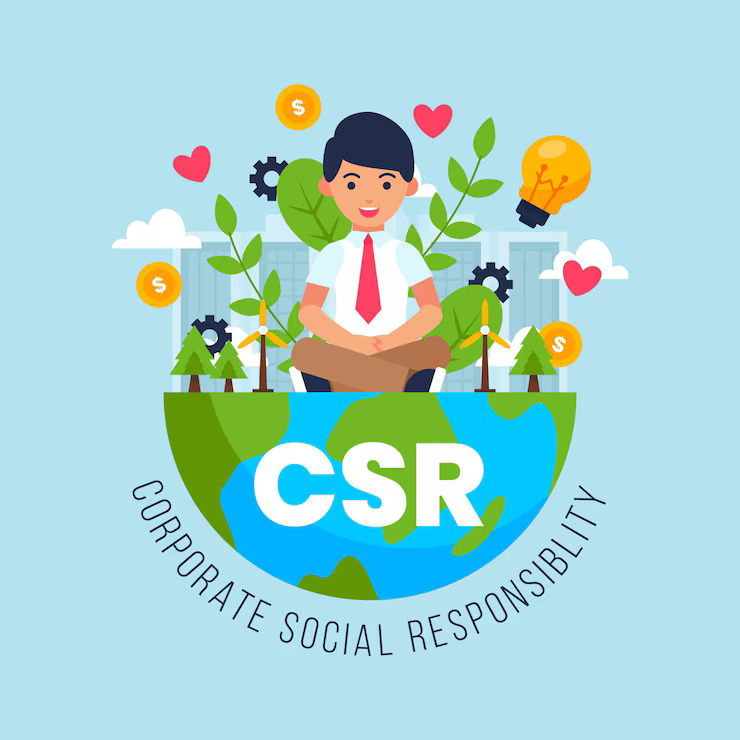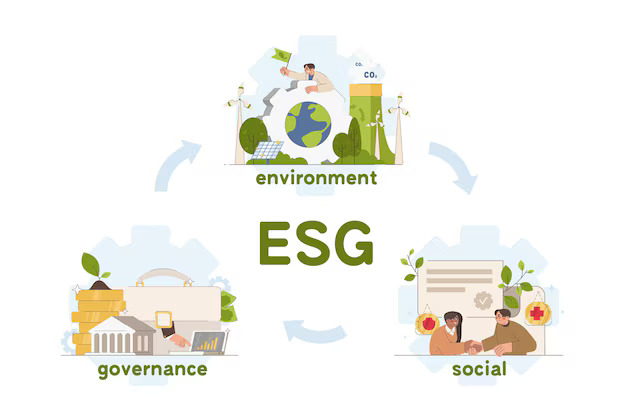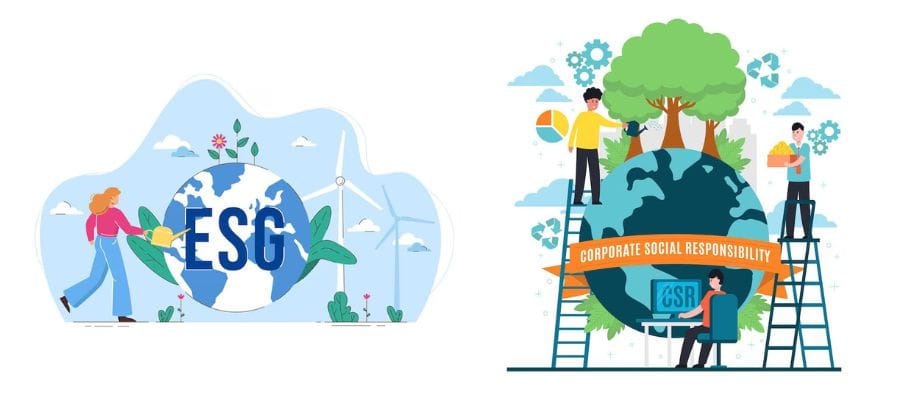In constantly changing business world, executives who want to connect their firms with sustainable practices must first comprehend CSR vs ESG key differences. Corporate Social Responsibility (CSR) and Environmental, Social, and Governance (ESG) are two independent frameworks that help corporations with their sustainability initiatives. While both seek to promote ethical standards and social responsibility, they differ in scope, implementation, and impact.
CSR is frequently considered as a company’s internal commitment to ethical standards, with an emphasis on volunteer actions that benefit society. In contrast, ESG refers to a set of quantifiable criteria used by investors and stakeholders to evaluate a company’s sustainability performance. Recognizing the CSR vs ESG key differences allows business executives to make educated decisions that are consistent with their organization’s aims and stakeholder expectations.

Understanding CSR: A Voluntary Commitment
Corporate Social Responsibility (CSR) is a company’s voluntary commitment to operating in an economically, socially, and ecologically responsible manner. It includes actions that go beyond legal requirements to represent a company’s ideals and ethical standards. Community participation, charitable giving, employee welfare initiatives, and environmental protection are all common CSR activities.
The major goal of CSR is to instill confidence and goodwill in stakeholders by demonstrating a company’s commitment to social and environmental issues. Unlike ESG, CSR lacks established measurements, making it difficult to assess its impact. However, CSR is critical in establishing a company’s culture and public image, encouraging employee participation, and increasing consumer loyalty. Understanding the CSR vs ESG key differences is essential for business leaders to effectively integrate CSR initiatives that resonate with their company’s mission and values.
Exploring ESG: A Data-Driven Approach
To understand the CSR vs ESG key differences, consider how ESG functions through quantifiable performance and responsibility. Unlike traditional CSR activities, ESG is heavily based on measurable data, making it simpler for investors and stakeholders to assess a company’s ethical and environmental performance. Here’s how each component of ESG works in a data-driven context:
- Environmental Metrics
ESG measures a company’s environmental impact using variables such as greenhouse gas emissions, energy use, water use, and waste management. This quantitative method differs from CSR, which frequently focuses on larger, voluntary environmental initiatives. Understanding these data points is crucial for determining how organizations lessen their environmental effect, highlighting one of the most significant CSR vs ESG key differences. - Social Metrics
Employee diversity, workplace safety, labor policies, and community participation are all examples of social criteria in ESG. Companies must gather and report on these areas using established frameworks. This allows stakeholders to examine social responsibility objectively, as opposed to CSR, where social contributions may not be supported by quantitative outcomes. - Governance Metrics
Governance in ESG is concerned with board diversity, executive remuneration, shareholder rights, and ethical company operations. These are usually reviewed using compliance data and transparency reports. Governance indicators show responsibility and long-term stability, indicating another major distinction when comparing CSR vs ESG key differences.
By concentrating on real facts, ESG allows firms to evaluate progress, benchmark against peers, and meet both regulatory and investor expectations, distinguishing itself from CSR, which is frequently narrative-driven.

CSR vs ESG Key Differences
To further elucidate the CSR vs ESG key differences, consider the following comparison:
| Aspect | CSR | ESG |
|---|---|---|
| Nature | Voluntary and self-regulated | Mandatory and regulated |
| Focus | Internal values and ethics | External performance and risk assessment |
| Measurement | Qualitative | Quantitative |
| Stakeholders | Employees, customers, community | Investors, regulators, stakeholders |
| Reporting Standards | Non-standardized | Standardized (e.g., GRI, SASB, TCFD) |
| Impact Assessment | Subjective | Objective and data-driven |
| Integration | Often peripheral to core strategy | Integrated into core business strategy |
Understanding these distinctions is vital for business leaders to develop comprehensive sustainability strategies that align with both internal values and external expectations.
Aligning CSR and ESG with Business Goals
It takes a strategic strategy that is in line with company goals to incorporate CSR and ESG frameworks into business operations. ESG practices may draw investors and guarantee regulatory compliance, while CSR activities can improve employee happiness and brand reputation. Skillsoft
To successfully match corporate objectives with CSR and ESG:
- Evaluate Organizational Values: Determine the ethical norms and fundamental principles that all parties involved find appealing.
- Establish Clear Goals: Give CSR and ESG projects precise, quantifiable objectives.
- Involve Stakeholders: Include workers, clients, and financiers in sustainability initiatives.
- Monitor and Report: Continually assess development and openly share outcomes.
Business executives may adjust their tactics to get long-term success and sustainable growth by knowing the CSR vs ESG key differences.
Case Study: Unilever’s Approach Highlights CSR vs ESG Key Differences in Practice
Seeing the CSR vs ESG key differences via actual company operations helps one better understand them. Unilever, a global corporation that has carefully balanced the CSR and ESG frameworks to promote sustainable success, is among the most striking instances.
The foundation of Unilever’s CSR activities has traditionally been voluntary programs that demonstrate the business’ dedication to moral responsibility. Through initiatives like the Unilever Sustainable Living Plan, the firm has made significant investments in community upliftment, sustainable sourcing, and health and hygiene education. With the goal of improving lives beyond its immediate commercial interests and fostering goodwill with communities and workers, these programs show Unilever’s alignment with corporate social responsibility.
In terms of ESG, Unilever has put in place a data-driven approach with quantifiable sustainability targets that satisfy investors. Using frameworks such as the TCFD (Task Force on Climate-related Financial Disclosures) and SASB (Sustainability Accounting Standards Board), the corporation releases yearly ESG performance reports. Quantifiable measures like supply chain governance, water efficiency, and carbon reduction targets—all crucial pillars under the ESG umbrella—are included in these reports.
This obvious dual implementation draws attention to the main operational CSR vs ESG key differences. ESG has been crucial in drawing in ethical investors and guaranteeing long-term risk management, while CSR has assisted Unilever in fostering social ideals and brand loyalty. When taken as a whole, these frameworks have improved Unilever’s market dominance and elevated it to the status of a model for ethical business practices. This case study demonstrates to business executives that comprehending and successfully implementing the major distinctions between CSR and ESG is not only a theoretical exercise but rather a useful road map for attaining stakeholder trust, ethical integrity, and long-term company growth.
FAQs on CSR vs ESG Key Differences
Q1: Can a company implement both CSR and ESG?
Yes, integrating both frameworks can provide a comprehensive approach to sustainability, combining ethical commitments with measurable outcomes.
Q2: Which framework is more important for investors?
Investors typically prioritize ESG due to its standardized metrics and ability to assess risk and performance objectively.
Q3: How do CSR and ESG impact brand reputation?
CSR builds brand goodwill through ethical actions, while ESG boosts credibility with measurable data—highlighting CSR vs ESG key differences.








